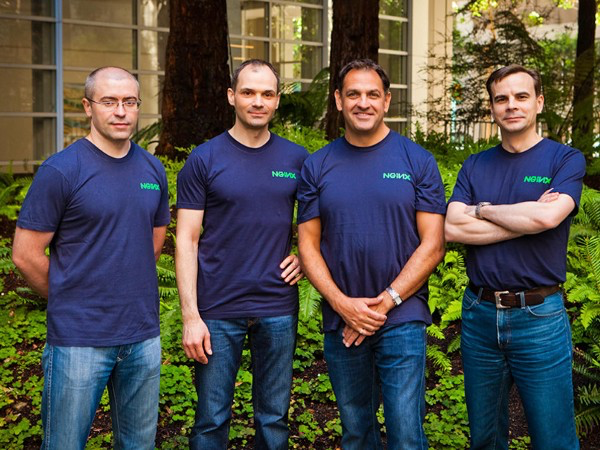With profound appreciation and gratitude, we announce today that Igor Sysoev – author of NGINX and co‑founder of NGINX, Inc. – has chosen to step back from NGINX and F5 in order to spend more time with his friends and family and to pursue personal projects.
Igor began developing NGINX in the spring of 2002. He watched the meteoric growth of the early Internet and envisioned a better way to handle web traffic, a novel architecture that would allow high‑traffic sites to better handle tens of thousands of concurrent connections and cache rich content such as photos or videos that was slowing down page loads.
Fast forward 20 years, and the code that Igor created now powers the majority of websites running on the planet – both directly and as the software underlying popular servers like Cloudflare, OpenResty, and Tengine. In fact, one could easily argue that Igor’s vision is a key part of what makes the web what it is today. Igor’s vision and values then shaped the company NGINX, Inc., fostering a commitment to code excellence and transparency powered by open source and community, while simultaneously creating commercial products that customers loved.
This is not an easy balancing act. That Igor is held in such high esteem by community and developers, enterprise customers, and NGINX engineers is a testament to his leadership by example with humility, curiosity, and an insistence on making great software.
A Brief History of Igor and NGINX
Igor came from humble beginnings. The son of a military officer, he was born in a small town in Kazakhstan (then a Soviet republic). His family moved to the capital Almaty when he was a year old. From a young age, Igor was fascinated with computers. He wrote his first lines of code on a Yamaha MSX as a high schooler in the mid‑1980s. Igor later graduated with a degree in computer science from the prestigious Bauman Moscow State Technical University as the early Internet was beginning to take shape.
Igor started working as a systems administrator but continued to write code on the side. He released his first program in assembly language in 1999, the AV antivirus program which guarded against the 10 most common computer viruses of the time. Igor freely shared the binaries, and the program was widely used in Russia for several years. He started work on what would become NGINX after he realized that the way the original Apache HTTP Server handled connections could not scale to meet the needs of the evolving World Wide Web.
In particular, Igor sought to solve the C10k problem – handling 10,000 concurrent connections on a single server – by building a web server that not only handled massive concurrency but could also serve bandwidth‑hogging elements such as photos or music files more quickly and efficiently. After several companies in Russia and abroad began using NGINX, Igor open sourced the project with a permissive license on October 4, 2004 – the 47th anniversary of the day the USSR launched Sputnik, the world’s first artificial satellite.
For seven years, Igor was the sole developer of NGINX code. During that period, he wrote hundreds of thousands of lines of code and grew NGINX from a web server and reverse proxy into a true Swiss Army Knife™ for web applications and services, adding key capabilities for load balancing, caching, security, and content acceleration.
NGINX rapidly gained market share, even though Igor spent zero time evangelizing the project and documentation was limited. Even with a missing manual, NGINX worked and word spread. More and more developers and sysadmins used it to solve their problems and accelerate their websites. Igor didn’t need praise or promotion. His code spoke for itself.
NGINX Goes Commercial But Stays True to Open Source
In 2011, Igor formed the company NGINX, Inc. with co‑founders Maxim Konovalov and Andrew Alexeev, in order to accelerate development velocity. Even though Igor understood that now he and his team needed to figure out ways to make money, they made a vow to maintain the integrity of the open source version of NGINX and to keep its permissive license. He has been true to his word. Under Igor’s direction, NGINX has consistently improved its open source product in more than 140 releases since the company’s founding. Today NGINX software powers hundreds of millions of websites.

In 2011, the idea of adding functionality to a commercial version in the form of proprietary modules was novel thinking; today, numerous open source startups follow this path. When that commercial version, NGINX Plus, launched in 2013, it was warmly received. Four years later, NGINX had over 1,000 paying customers and tens of millions in revenues, even as NGINX Open Source and the NGINX community continued to grow and prosper. By the end of 2019, NGINX was powering more than 475 million websites and in 2021, NGINX became the most widely used web server in the world.
Always looking to the future, Igor has overseen the rapid development of other popular NGINX projects, including NGINX JavaScript (njs) and NGINX Unit. He also architected a new implementation of the sendfile(2) system call which was incorporated into the open source FreeBSD operating system. And as the ranks of NGINX engineers have grown and the company has joined F5, Igor has remained a steady behind-the-scenes presence, providing vision and guidance that has kept NGINX on the right path.
Carrying On Igor’s Legacy of Excellence
Today, our paths diverge with Igor stepping back for a well‑deserved break. Fortunately, his ethos and the culture he created are not going anywhere. In great companies, products, and projects, the DNA of the founder is persistent and immutable. Our approach to products, community, transparency, open source, and innovation have all been shaped by Igor and will continue with Maxim and the NGINX leadership team.
The ultimate legacy of Igor’s time with NGINX and F5 is, of course, the code itself. Igor wrote much of the code that is still in use today. The test of time will be whether we can continue to write code as timeless and create products as useful and widely respected as Igor has. It’s a high bar, but Igor has left us in a good place to live up to these aspirations. Igor – thank you so much for all the years working with us and we wish you the very best in your next chapter.


